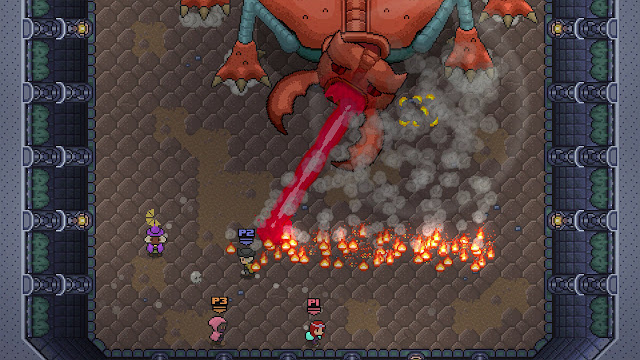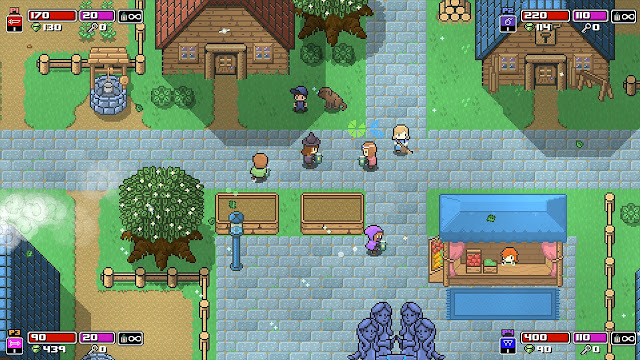Welcome to a new week of content here at SuperPhillip Central! To start the week off, here's a review for a game releasing tomorrow on both Nintendo Switch and PC. It's Heliocentric Studios' ode to The Legend of Zelda: A Link to the Past mixed in with some roguelite aspects for good measure. It's Rogue Heroes: Ruins of Tasos, and this is the SPC review.
A Link to the Roguelite
One of my favorite Super Nintendo games ever made is The Legend of Zelda: A Link to the Past. Its combination of excellent gameplay, engrossing world, compelling story and characters, engaging dungeon exploration, and pristine presentation all made for a near-perfect adventure. No doubt Heliocentric Studios are big fans of A Link to the Past, too, as their newest game, Rogue Heroes: Ruins of Tasos, borrows a lot from Nintendo's 16-bit classic. What Rogue Heroes ends up being is a game heavily reminiscent of A Link to the Past's gameplay with roguelite elements added, and fortunately for me, this mixture of concepts--rather than being an issue from someone who isn't all too keen on the genre--organically works well enough to make one memorable and most importantly fun game.
Rogue Heroes: Ruins of Tasos immediately shows its clear inspirations from A Link to the Past, with your character being able to strike their sword in one of eight different directions, pull out their shield to deflect attacks, slash bushes and signposts, grab and throw small rocks, break pots, and utilize a wide array of tools and equipment like the bow and arrow, a hookshot-like grappling hook, a boomerang, bombs, and even a shovel to dig up secrets in the interconnected overworld.
The primary premise of Rogue Heroes requires you to defeat four titans resting in four dungeons on the north, south, east, and west areas of Tasos. Each dungeon possesses a combination of puzzles and combat trials to take on in each of their three floors. These puzzles include everything from pushing blocks onto pressure plates to reveal treasure chests, lighting torches, hammering down buttons in a short amount of time, or simply clearing the room of all enemies. This is all the while claiming keys to open locked doors and collecting gems that you can spend in your makeshift town in the central region of Tasos.
 |
| Up to four players can delve inside and outside of dungeons in Rogue Heroes. |
Each of the four major dungeons in Rogue Heroes has its own theme, from a swamp-themed dungeon to the third dungeon's lava motif, and an assortment of rooms that are procedurally cycled between so no two runs in a dungeon are the same. They all put your various tools through the wringer, offering plenty of opportunities to use them and use them well.
Each dungeon's climax features a boss to defeat. Some of these bosses take up half the screen, littering the battlefield with falling rocks and debris to avoid, or firing projectiles in a set pattern throughout the combat zone. Upon beating a boss, you earn a permanent addition to your tool roster as well as getting one step closer to having defeated all four titans and making your way to the final encounter that awaits.
 |
| Whoa! Maybe take some mints for that spicy breath of yours, pal. |
When you're not inside one of the compellingly crafted procedurally designed dungeons of Rogue Heroes, you're given plenty of downtime between dungeons. This is rather enjoyable as well, as the overworld slowly opens itself up as you gain new equipment and tools. You're met with bridges that require the grappling hook to cross their broken segments, weak boulders that can be blasted with bombs to reveal a path, pegs that can be smashed down with the hammer to progress, and more. Shortcuts abound in Rogue Heroes' overworld as well, offering warp statues that can take your hero around Tasos quickly, as well as makeshift ramps that can be created to make getting around Tasos even easier. In true A Link to the Past and Zelda fashion, with Rogue Heroes, you're not just moving from dungeon to dungeon. You're given time to fully explore the rich and entertaining world of Tasos and its plains, plateaus, forests, swamps, caves, and tundra in its borders.
 |
| Not only is the broken bridge over some troubled water, but the bridge itself seems troubled as well! Talk about some serious disrepair! |
Then, there are the side quests that pop up that offer the opportunities for some optional content. Whether it be reuniting a ghost with their family by venturing into an elective mausoleum dungeon and defeating the horde of undead inside, or searching the southwestern beach for the lost and marooned husband of one of your townspeople, there's plenty of side content to be found and to partake in with Rogue Heroes.
Speaking of townspeople, with the gems you earn from dungeons scattered around Tasos, you can turn the squalid, barren land sitting in the center of the land and turn it into a bustling community. By talking with Griff, a helpful NPC, you can build a wide assortment of buildings and homes for islanders to move in and bestow upon you their individual and unique kinds of help. You can place buildings on any available plot of land you like, giving you a sense of your town being yours. Not only can gems be spent on constructing new buildings, but they can also be spent on various skill trees at the various vendors around town. From increasing your attack capabilities at the blacksmith or pumping up your amount of health and magic at the hospital, to learning new jobs with purchased thread or building up your stamina at the fitness center, these stores and shops provide A TON of different skill trees available to you to further along your character. Perhaps it would have been easier to streamline these to one specific menu, as what is here results in plenty of places to pump up your character's abilities, which can result in mild annoyance and confusion, as well as a fair amount of traversing from shop to shop to spend gems.
 |
| It's a good idea to return to town often in Rogue Heroes so you can spend your gems and upgrade your abilities. |
At the start of Rogue Heroes, I was essentially made of glass, quickly dying in dungeons due to my lack of health and strength, but as I gained and spent more gems on new health and attack upgrades, my hero made of glass turned into an unstoppable, infallible killing machine. This is how I imagine most players will find their experience with the game. The first dungeon will most likely be the most difficult, resulting in the most deaths, due to being so weak and having such a paltry amount of health. However, death isn't too punishing in Rogue Heroes. You don't really lose anything--not gems, not coins--all you really lose is your progress in a given dungeon. Even then, you can spend gems at special statues on each floor to make a permanent shortcut for you on return trips so you can skip ahead to the second or third floors at your leisure.
Rogue Heroes also features co-op play in both local and online varieties to try out, also at your leisure. Having multiple players at once allows for easier combat situations, but for dungeons, it makes puzzles more challenging. For instance, a puzzle involving carrying an orb to its final resting place to open a door is a simple task while playing solo. You just pick up the orb and meander around the room and drop it in its vessel. In co-op it is more complex, as specific sections of tile result in the orb being destroyed and send back to its initial spot. In order to complete the puzzle in co-op, you need to toss the orb between players over the tile-free zones of the room multiple times to finally get it in its resting place to satisfy the conditions of the puzzle and to solve it.
Fortunately, if one of your party member dies (they can either get brought back by carrying their skull to a special altar to revive them or by completing or otherwise exiting the dungeon you're currently in), puzzles immediately alter themselves to fit how many current active players are there. So, in other words, if a player dies mid-puzzle and that puzzle required two players to stand on two different pressure plates to open a door, a block will spawn so the puzzle isn't unsolvable for the solo player. A very smart and a very good thing to not have a design oversight on!
 |
| Even a day at the beach isn't just a day at the beach in Tasos when you've got monsters roaming the sands! |
If there are any problems I do have with Rogue Heroes, it's twofold. For one, while there are various classes to change into by finding magical threads scattered around Tasos and returning them to the tailor in town, these classes aren't so easily distinguishable between one another other than having slightly altered stats and a specific move tied to the B button. Whereas the Hero class can dash a la Link with his Pegasus Boots equipped and the Knight class can pounce forward, stunning enemies nearby, there really isn't too incredibly much of a discernible difference between classes.
Secondly, I ran into several glitches in my 16-hour play-through of Rogue Heroes. Sometimes dungeons were generated in a way where there was literally no way to progress inside, as there simply weren't enough keys available. This happened very rarely, but it was obnoxious when it happened all the same. Other times I saw odd glitches where my character was either not on the same layer as objects and enemies, resulting in my sword passing right through them with no effect whatsoever. This glitch would end by simply leaving the current room of a dungeon or area of the overworld. But, the glitch that didn't end until I backed out of the game was an audio one, where the sound of rushing water followed--nay, haunted me wherever I went, even to the title screen. Quitting the game completely solved this, and while it only happened once, that sound of water will forever haunt my dreams. Okay, maybe I'm exaggerating just a tad, but it was inconvenient all the same.
Rogue Heroes: Ruins of Tasos succeeds in making a unique roguelite that blends the tried and true gameplay of games like The Legend of Zelda: A Link to the Past and mixes it in a way that makes this particular roguelite actually enjoyable. That's not to say that I don't care for roguelites in general, but after seeing an onslaught of the genre and their roguelike cousins in general from indies and larger devs alike, it's great to see one in Rogue Heroes that doesn't just adhere to the genre's template so stringently. There's plenty of time to breathe when exploring the overworld of Tasos, the dungeons are filled with brain-bending puzzles and engrossing battles, and the penalty for death won't overly diminish your joy or demotivate you too easily. Rogue Heroes: Ruins of Tasos is a great marriage between A Link to the Past gameplay and roguelite design, tremendously fun and polished, making it a recommended title whether you enjoy it alone or with others in co-op play.
[SPC Says: B+]
A code was received by SPC from the publisher for the purpose of writing this review.


No comments:
Post a Comment